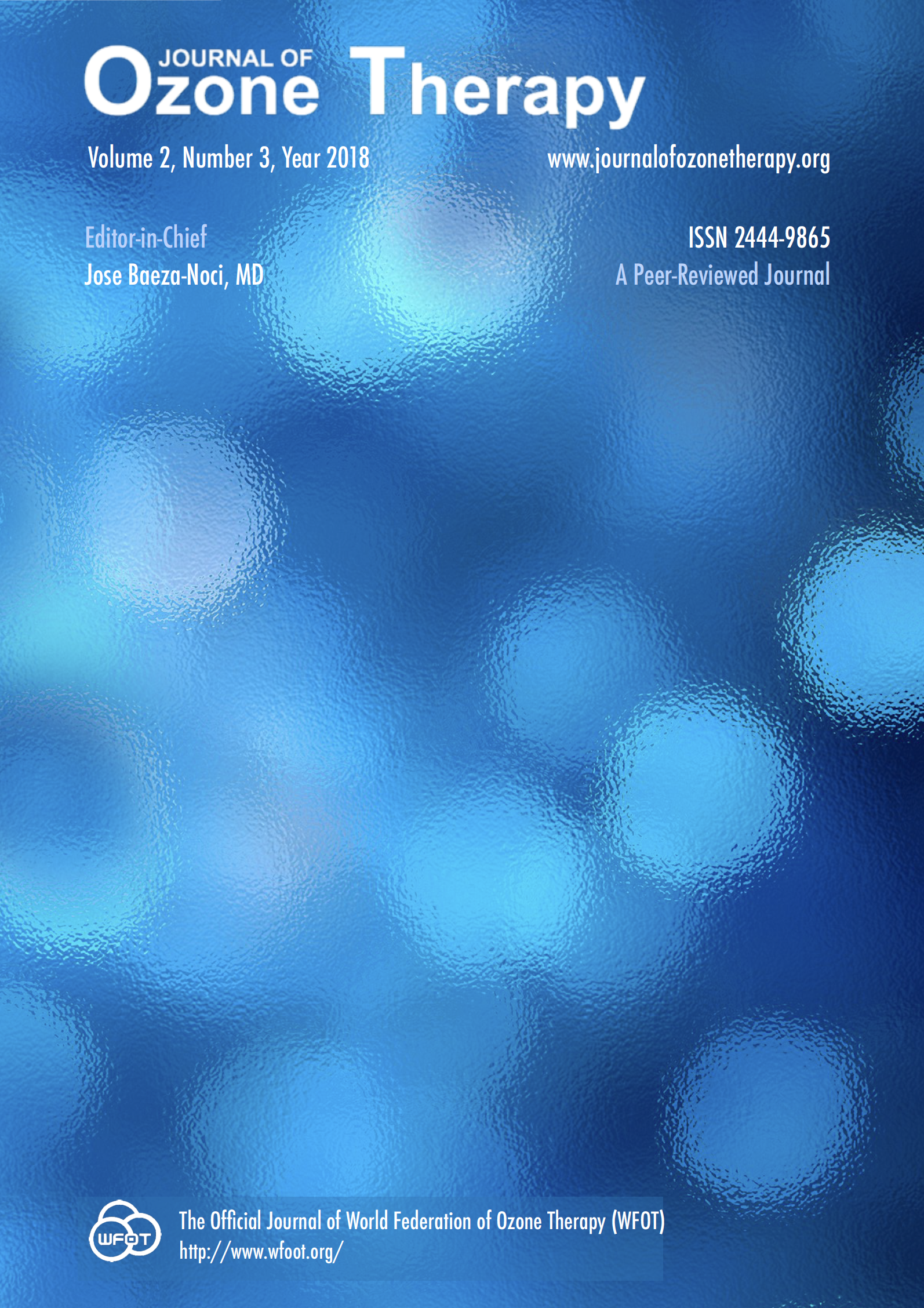Clinical study of patients with heart failure under treatment with ozone therapy
DOI:
https://doi.org/10.7203/jo3t.2.3.2018.11461Keywords:
Heart failure (HF), Major Autohemotherapy, Ozone therapy, Fracture of Left Ventricular Ejection Abstract
Abstract
Heart failure (HF) is framed in one of the types of cardiovascular diseases; it consists of an acute and chronic form. The disease can evolve slowly from asymptomatic left ventricular dysfunction, to a state of severe disability, presenting a wide prevalence in the population around 10% in people over 70 years old. More than three-quarters of the deaths from this pathology normally occur in low or middle-income countries. Angola is not exempt from this health problem be observed in a relatively young people, bringing disability and death at an early stage of life. Scientific advances and innovative treatments for the control and prevention of the disease continue to be insufficient.
The ozone for it’s antioxidant, hemorheologic properties, oxygenation enhancers and blood circulation is an alternative treatment for these patients.
We have performed a study where 45 patients who were diagnosed with a chronic stage of II-III HF due to the functional classification of the New York Heart Association (NYHA) and American Cardiology College / American Heart Association (ACC / AHA), previous echocardiogram with a Fracture of Left Ventricular Ejection (LVEF) less than 45%. We administered a Major Autohemotherapy with a protocol of 15 sessions, maintenance every 15 days and cycles every 6 months at 50?g of concentration, an initial dose of 4,000 ?g / ml up to 12,000?g / ml during the 3 years of treatment.
Patients after the first treatment cycle improve their functional physical capacity and LVEF increased to normal levels (55%). It was proved that Autohemotherapy is an adjuvant, viable and beneficial treatment in chronic HF.
Key words: Heart failure (HF), Major Autohemotherapy, Ozone therapy, Fracture of Left Ventricular Ejection
 Downloads
Downloads
 References
References
Krumholz HM, Chen YT, Wang Y, Vaccarino V, Radford MJ, Horwitz RI. Predictors of readmission among elderly survivors of admission with heart failure. Am Heart J. 2000;139(1):72-77.
Cowie MR. Annotated references in epidemiology. Eur J Heart Fail. 1999;1:101-107.
Ho KK, Pinsky JL, Kannel WB, Levy D. The epidemiology of heart failure: the Framingham Study. J Am Coll Cardiol. 1993;22(4 Supl A):6-13.
McKee PA, Castelli WP, McNamara PM, Kannel WB. The natural history of congestive heart failure: The Framingham study. N Engl J Med. 1971;285:1441-1446.
Damasceno A, Cotter G, Dzudie A, Sliwa K, Mayosi BM. Heart Failure in Sub-Saharan Africa: Time for Action. J Am Coll Cardiol. 2007;50(17):1688-1693. doi: 10.1016/j.jacc.2007.07.030.
Cleland JGF, Gemmel I, Khand A, Boddy A. Is the prognosis of heart failure improving?. Eur J HeartFail. 1999;1(3):229-241.
Travagli V, Zanardi I, Bernini P, Nepi S, Tenori L, Bocci V. Effects of ozone blood treatment on the metabolite profile of human blood. Int J Toxicol. 2010 Mar;29(2):165-174. doi: 10.1177/1091581809360069.
Re L. Mawsouf MN, Menéndez S, León OS, Sánchez GM, Hernández F. Ozone Therapy: Clinical and basic evidences of its therapeutic potential. Arch Med Res. 2008;39:17-26. doi: 10.1016/j.arcmed.2007.07.005.
Hurst JW, Morris DC, Alexander RW. The use of the New York Heart Association's classification of cardiovascular disease as part of the patient's complete Problem List. Clin Cardiol. 1999;22(6):385-390.
Borroto-Rodríguez V, Suárez-Fleitas LR, Bocci V, Luisa B, Lima-Hernández LB, Cámbara-Peña R, et al. Ozonoterapia en la Insuficiencia Cardiaca Crónica [Ozonetherapy in chronic heart failure]. Revista Española de Ozonoterapia. 2016;6(1):9-26.
Merin O, Attias E, Elstein D, Schwalb H, Bitran D, Zimran A, et al. Ozone administration reduces reperfusion injury in an isolated rat heart model. J Card Surg. 2007;22(4):339-342. doi: 10.1111/j.1540-8191.2007.00419.x.
Barackat SAE, Saleh NKM, Thabet SS, Salej HA, Fayez MA. Effect of medical ozone therapy on diabetes-induced cardiac dysfunction. JASMR. 2008;3:167-175.
Downloads
Published
How to Cite
-
Abstract5052
-
PDF476
Issue
Section
License
Journal of Ozone Therapy applies the Creative Commons Attribution-NonCommercial 4.0 International License (CC BY NC 4.0) license to works we publish.
Under this license, authors retain ownership of the copyright for their content, but allow anyone to download, reuse, reprint, modify, distribute and/or copy the content as long as the original authors and source are cited. No permission is required from the authors or the publishers.
You may not use the material for commercial purposes.
Appropriate attribution can be provided by simply citing the original article, provide a link to the license, and indicate if changes were made.
You may do so in any reasonable manner, but not in any way that suggests the licensor endorses you or your use.




